What Are Springtails?
Springtails are tiny, primitive insects that belong to the Collembola order. They are usually less than 6 mm in length and are known for their ability to “spring” into the air, thanks to a specialized structure called a furcula, a tail-like appendage that is folded beneath their body and can be released to help them jump when threatened.
What Kinds of Springtails are There?
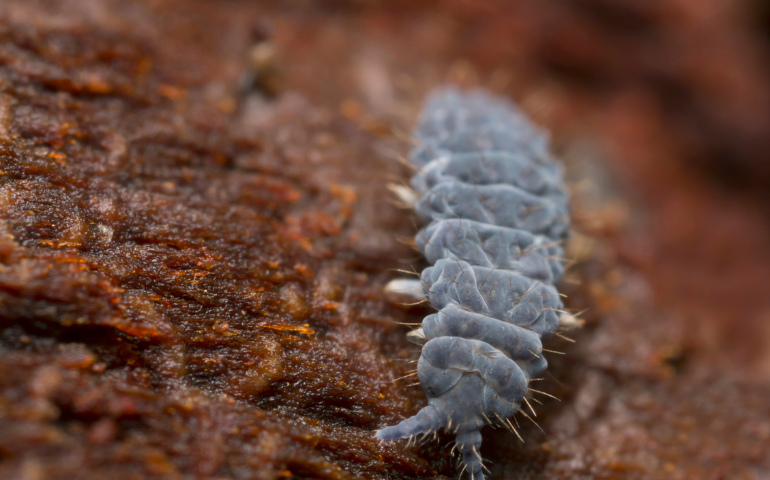
Snow fleas are a type of springtail commonly seen in winter, especially on snow surfaces, where they look like tiny black specks. These insects don’t actually bite or infest homes; instead, they thrive in damp outdoor environments and play a vital role in decomposing organic material. They get their name because they’re often spotted hopping around on the snow, especially near melting patches.
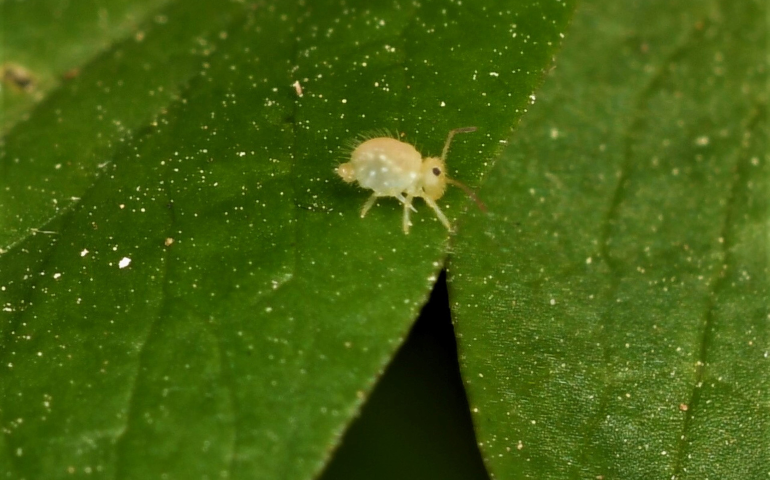
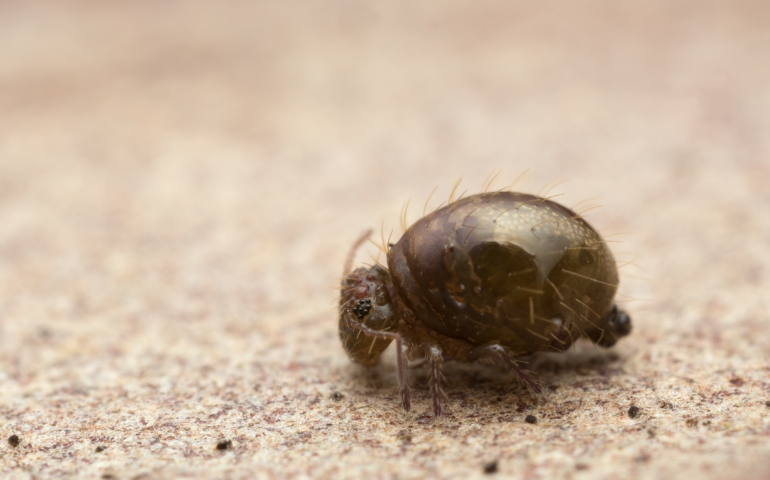
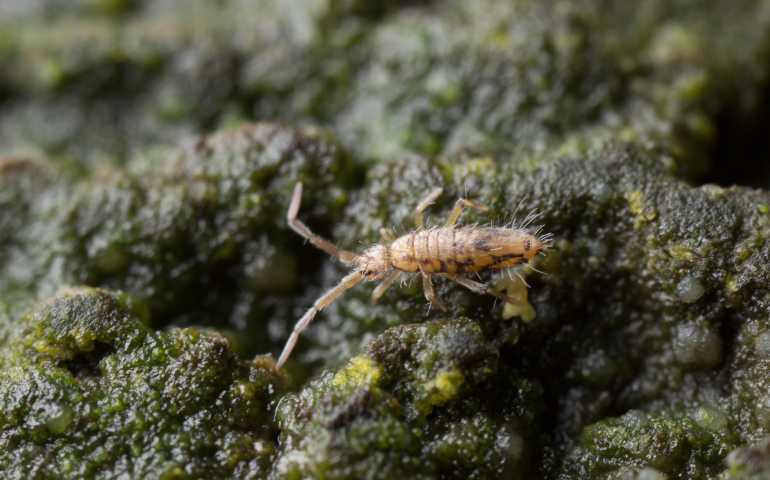
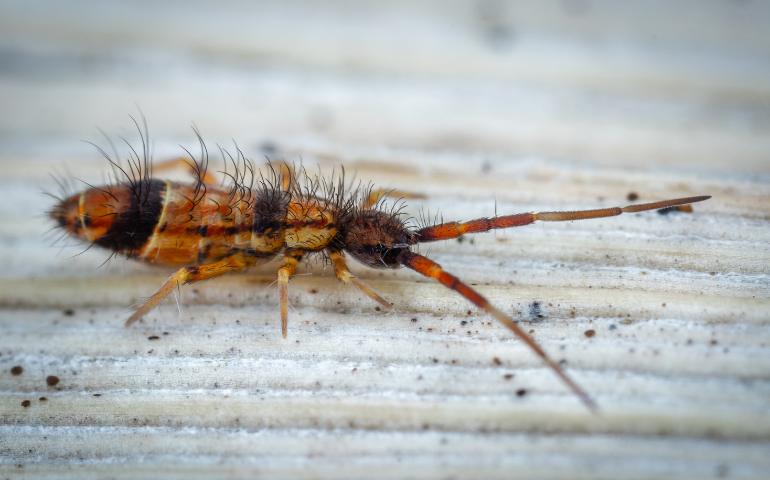
Orchesella springtails are larger and more colorful than other springtail species, with distinctive brown and yellow bands. They are often found outdoors in leaf litter, compost piles, or under logs. Their colorful appearance and larger size make them easy to spot, but like other springtails, they’re harmless and aid in breaking down organic material in the ecosystem.
What Do Springtails Look Like?

Springtails exhibit a variety of characteristics that distinguish them from other hexapods and enable them to thrive in diverse environments. Here are some key characteristics of springtails:
Size and Shape
Most springtails are tiny, typically ranging from 0.25 to 6 mm in length. Their body shapes can vary widely among different families, from the elongated forms of the Entomobryidae to the compact, globular bodies of the Sminthuridae.
Coloration
Springtails can be found in a range of colors, including white, gray, black, yellow, and sometimes bright colors like blue, green, and red. Their coloration can help with camouflage or warning predators of their potential toxicity.
Furcula
This is a forked tail-like structure tucked under the abdomen, which springtails use for jumping. When released, it snaps against the substrate, propelling the springtail into the air. This mechanism is primarily used as a defense to escape predators.
Collophore
Located on the ventral side of the first abdominal segment, this tube-like structure helps in moisture absorption and regulation. It’s believed to be a vestigial organ that might have been used in salt and water balance.
Other Characteristics of Springtails

Habitat Adaptation
Springtails are primarily found in moist environments, which they need to avoid desiccation due to their small size and large surface area relative to their volume. However, they can also be found in diverse habitats, including ant nests, tree canopies, caves, and even in Antarctica.
Reproduction
Springtails do not undergo complete metamorphosis like many insects. They often reproduce through parthenogenesis (a form of asexual reproduction), although sexual reproduction also occurs. Eggs are laid in moist soil or leaf litter, and the young generally resemble adults, growing through a series of molts.
Diet
They primarily feed on fungi, decaying vegetation, bacteria, algae, and pollen, playing crucial roles in nutrient cycling and soil health.
Sensory Organs
While they lack compound eyes, many springtails have simple eyes (ocelli), which can detect light but do not provide detailed vision. They rely more on their antennae for sensing their environment.
What Problems Do Springtails Cause?
Springtails are generally harmless and do not pose any health risks to humans or animals, as they do not bite, sting, or transmit diseases. However, they can occasionally become a nuisance, especially when they invade homes in large numbers. This typically occurs when their outdoor habitats become too dry or flooded, prompting them to seek more favorable conditions indoors. Inside a home, springtails are attracted to moist areas such as kitchens, bathrooms, basements, and areas around leaking pipes.
While they do not cause structural damage or spoil food, their presence can be bothersome to homeowners. Additionally, in greenhouses or nurseries, high populations of springtails may damage tender plant roots or seedlings by feeding on them, although this is relatively rare. The main issue with springtails indoors is their sheer numbers, which can become a significant nuisance rather than a direct threat or damage.
How To Get Rid Of Springtails With Extermination
When dealing with a springtail infestation that requires extermination, we follow a comprehensive approach to ensure effective and environmentally friendly treatment. Here’s how we typically handle springtail extermination:
Assessment
We start with a thorough inspection of your home to identify the sources of the springtail infestation and the conditions promoting their presence. This often involves checking for high moisture areas, leaks, and potential entry points around the home.
Environmental Management
Reducing moisture is key to controlling springtails. We recommend practical changes such as improving drainage and ventilation, using dehumidifiers, and fixing leaks. These steps help create conditions that are less attractive to springtails.
Treatment
For active infestations, we use targeted treatments that are safe for indoor use and environmentally friendly. These might include insecticides that are specifically effective against springtails, applied in areas where springtails are concentrated, like bathrooms, basements, and kitchens.
Exclusion Techniques
We seal entry points that springtails could use to enter a home, such as gaps around doors, windows, and utility lines. This prevents new springtails from entering once the existing population is controlled.
Follow-Up
After the initial treatment, we schedule follow-up visits to reassess the situation. This ensures that the infestation is under control and allows us to make any necessary adjustments to our approach.
Preventative Advice
We provide ongoing advice and support to help prevent future infestations, including recommendations for maintaining low humidity levels and regular inspections of at-risk areas.
By following these steps, we ensure that your springtail problem is handled effectively, with consideration for your health and the environment. If you’re experiencing issues with springtails, contact Alta Pest Control to get professional, reliable, and swift service. Check out our locations to see if we can service your area. Also, keep reading to learn more about springtails in our FAQ section below!
